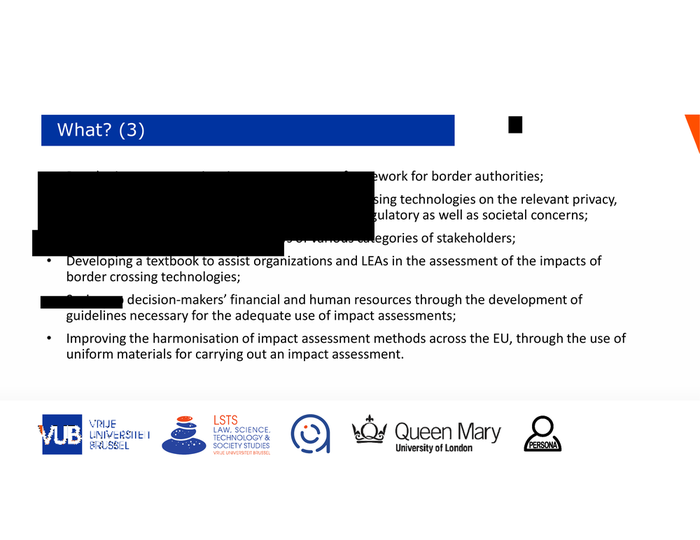persona
PERSONA Privacy, ethical, regulatory and social no- gate crossing point solutions acceptance Vrije Universiteit Brussel (VUB) Research Group on Law, Science, Technology & Society (LSTS) Queen Mary University of London (QMUL) The Multimedia and Vision Research Group Warsaw, 14 June 2018 FRONTEX - European Border and Coast Guard Agency Workshop on EU funded border security research projects

The seven circumstances • quis (who) • quid (what) • quando (when) • ubi (where) • cur (why) • quem ad modum (in what way) • quibus adminiculis (by what means)

Why? • European Commission identified a need • Call: H2020-SEC-2016-2017-2 • Topic: SEC-18-BES-2017- Acceptance of no gate crossing point solutions • “the intensive use of technologies bear the risk of invading people’s privacy, and the societal and political acceptance of technologies for “no gate solutions” is required prior to their implementation.” • Expected impact: “A method, and metrics, to assess acceptability by the society of the concept of border control processes based on "no gate crossing point solutions”, and of the various technology components that may be required.”

Why? (2) • Contribute to the work of • Technology developers • Researchers • Border authorities • LEAs • Policy-makers • Other stakeholders • by fostering proactive thinking in connection with • Privacy, Ethical, Regulatory and SOcial No-gate crossing point solutions Acceptance (PERSONA)

Why? (3) • PERSONA aims to develop a unified and tailored impact assessment method and to carry out comprehensive evaluations of wide range of contactless crossing point technologies, taking into account ethics, legal and otherwise regulatory requirements, privacy and personal data protection concerns, threats of discrimination and other societal issues. • The established method for assessment will provide robust information for decision-makers in a form of enumeration of potential threats and benefits, possible measures to minimise the former and maximise the latter as well as overall guidelines in order to drive the innovation and deployment of future solutions by both industry and border control authorities.

Why? (4) benefits overweigh costs • pros • cons • aids to: • bureaucracy • foster informed decision-making • waste of effort • the protection of societal concerns • complexity • forces to reflect • instrumental use • ex ante thinking/early warning system • inward/outward orientation • inward/outward orientation • best-effort obligation • demonstrates accountability • means for the public to have their voice heard

Who and where? • 10 partners • Belgium, Norway, Italy, Spain, Portugal, United Kingdom, Sweden, Austria, Serbia, Israel • Research: • Vrije Universiteit Brussel (VUB) • Institut for Fredsforskning Stiftelse Peace Research Institute Oslo (PRIO) • Queen Mary, University of London (QMUL) • SME: • Cyberethics Lab (CEL) • Industry: • Atos Spain S.A. (ATOS) • INOV Inesc Inovação (INOV) • LEA • Bundesrechenzentrum – Federal Computing Centre (BRZ) • Swedish Police Authority, National Forensic Centre (SPA) • Ministry of Interior of the Republic of Serbia (SMOI) • Ministry of Public Security – Israel National Police (MOPS-INP)

What? • Analysis of the existing assessment methods • PIA • Art. 8 ECHR • DPIA • Art. 35 GDPR • Art. 27 Directive • EIA • Autonomy, dignity, non-maleficence, beneficence • SIA • Societal acceptance • SIA • Security aspects • RIA • National Facilitation Programme • Registered Traveller Programme • eurodac, dublin, sis, eurosur, etc.

What? (2) an ideal impact assessment 1. Systematic process 9. Deliberative 2. Considers the relevant societal concerns 10. Accountable 3. Not everything needs it 11. Assessor is independent 4. Uses the appropriate method 12. Simple 5. Includes recommendations 13. Adaptive 6. Constitutes best efforts obligations 14. Inclusive 7. Relies on sufficient knowledge and know-how 15. Receptive 8. Documented 16. Grows in supportive environment

What? (3) • Developing an appropriate impact assessment framework for border authorities; • Identifying and assessing the impacts of border crossing technologies on the relevant privacy, personal data protection, ethical, legal and other regulatory as well as societal concerns; • Exploring and implementing the views of various categories of stakeholders; • Developing a textbook to assist organizations and LEAs in the assessment of the impacts of border crossing technologies; • Saving-up decision-makers’ financial and human resources through the development of guidelines necessary for the adequate use of impact assessments; • Improving the harmonisation of impact assessment methods across the EU, through the use of uniform materials for carrying out an impact assessment.










